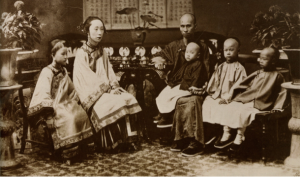
The exact origins of foot binding in China can not be explained by one event or one reason. In actuality there are many theories of how and when foot binding in China took place, why it continued for so long and what in meant in a social, cultural, political, national and familial context. It is known that foot binding came into practice during the Song Dynasty (960-1279), and foot binding remained the popular fashion in China until the early 1900’s. Foot binding survived in China for hundreds of years and it has stood as a symbol for many different purposes. For example in the seventeenth century foot binding was used to demonstrate Han Chinese civility. A bound foot also has represented beauty, femininity, social status, political loyalty, female oppression and female liberation. Foot binding can not be reduced to one story or one meaning because it has served for so many different purposes over a vast length of time. However I want to focus on the relationship between foot binding and the family. may start from this statement, due to word limit
Foot binding in China, among many things, represented femininity and beauty in concealment. In order to get married a woman must have had her feet bound, in fact small feet were often more important then a pretty face. A woman with her feet bound had to take small steps and she couldn’t travel very fall. This gave off the illusion of a delicate nature and also led to female dependence on male counterparts. Concealment, delicate femininity and a submissive nature became desired traits a woman sought after in her home life and were subsequently passed down from mother to daughter through the process of foot binding. stay with your statement: foot binding and family
This photo was taken by a professional photographer and is of a Chinese family. In this photo the girls and boys are clearly separated, which expresses the divide of power among men and women in the home. The man, presumably the husband, has his arm at rest and is staring directly into the camera. The sons are also staring straight into the camera, while the wife and daughter are staring off into the distance. This demonstrates that a woman is valued by her subtlety and reservedness.
Foot binding was a tradition that was passed on from mother to daughter, (topical claim) so although it was practiced throughout China, it was also a personal and familial matter. In this photo the mother and daughter are seated next to each other and are both dressed and and positioned almost exactly the same way. This portrays how mother and daughter relationships advanced traditions. The women’s feet are predominantly concealed, with just the tip of the lotus shoe revealed, demonstrating the idea of beauty in concealment. The woman are sitting up straight while the men are allowed to slouch. The women’s clothing is silk, ornate and well preserved. Their hair is well kept and decorated. The women in this photo appear well-mannered, civilized, polished and decorated, while the men seem more relaxed, they are less decorated and there feet are not bound. Although bound feet did emphasize the importance of a delicate and submissive women, it also put the power of conserving Chinese civility in the hands (or feet!) of the women, clearly demonstrated by this family portrait.
In the family, foot binding was just as complicated and multi faceted as it was in all of China. It separated the women from the men and it continued through mother-daughter relationships. While one could argue that this practice kept Chinese women weak and dependent, foot binding also put the emphasis of maintaining Chinese civility on the women of the home.
paragraph organization: 1) different between men and women; 2) relation between mother and daughter
